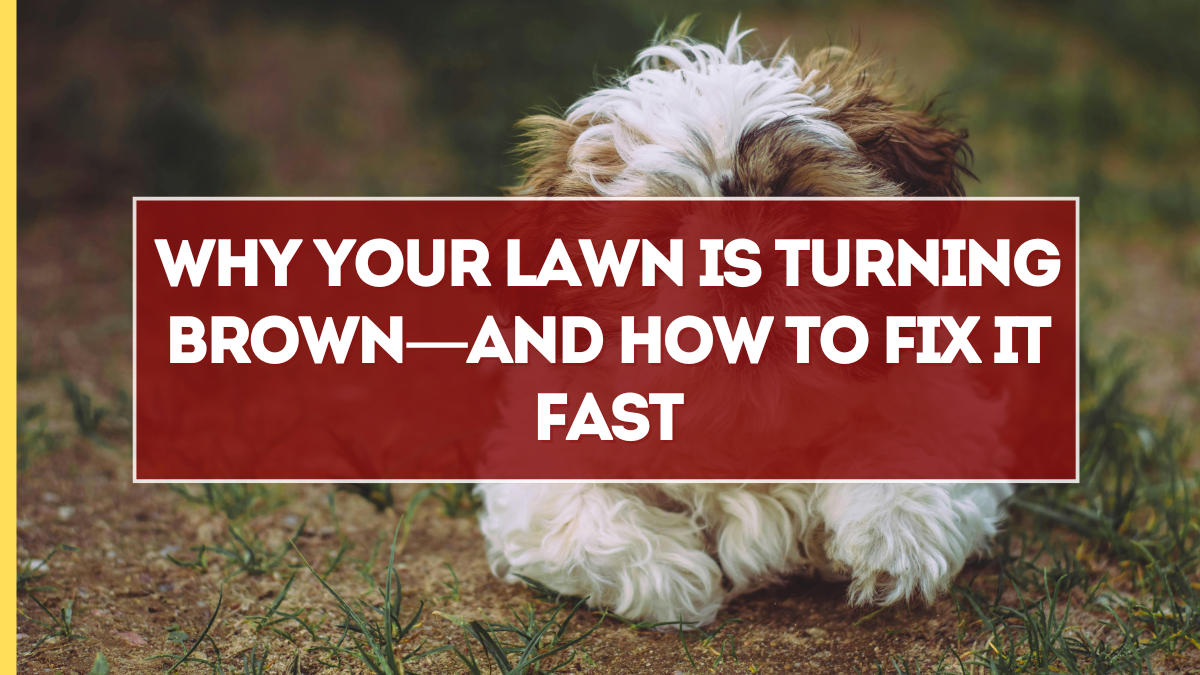Few things are more frustrating for homeowners than seeing a once-green lawn slowly fade into ugly brown patches. The first instinct is often to assume the lawn is dying, but in reality, there are several reasons why lawns turn brown—and many of them are fixable. From heat stress and drought to pests, fungal diseases, and poor lawn care habits, diagnosing the real cause is the key to bringing back healthy green grass.
This guide explains the most common causes of browning, how to identify them, and the exact fixes you can apply right now to restore your turf.

Heat Stress and Drought
One of the most common reasons for brown lawns in late summer and fall is heat stress. Grass, especially cool-season types, struggles when exposed to long periods of high temperatures.
Signs of heat stress include:
-
Grass turning tan or straw-colored.
-
Dry, brittle texture underfoot.
-
Lawn going dormant in patches.
Fix:
-
Water deeply but less frequently—1 to 1.5 inches per week, preferably in early morning.
-
Avoid shallow daily watering, which encourages weak roots.
-
Raise mowing height to provide shade for soil and roots.
-
In extreme heat, accept temporary dormancy; grass usually recovers once cooler weather returns.
Poor Watering Habits
Even when the weather is mild, watering mistakes can turn lawns brown. Both overwatering and underwatering stress the grass.
-
Overwatering drowns roots, creates oxygen-deprived soil, and invites fungus.
-
Underwatering dries out soil, weakens root systems, and accelerates browning.
Fix:
-
Use a rain gauge or sprinkler timer to monitor exact water levels.
-
Follow the “deep and infrequent” watering rule.
-
Ensure your lawn has proper drainage—if puddles form after watering, improve soil aeration.
Lawn Pests
Another reason why lawns turn brown is pest infestation. Certain insects feed on roots or blades, leaving irregular dead patches.
Common culprits include:
-
Grubs: White, C-shaped larvae that eat grass roots.
-
Chinch bugs: Suck sap from blades, causing yellowing that spreads into brown patches.
-
Armyworms or sod webworms: Feed on leaf blades, leaving chewed areas.
Fix:
-
Check under sod for grubs—more than 5–10 per square foot indicates a problem.
-
Use targeted insecticides or natural controls like beneficial nematodes.
-
Reseed bare patches once pests are removed.
Fungal Diseases
Lawns often turn brown due to fungal infections, especially when humidity is high.
Common lawn fungi include:
-
Brown patch: Circular areas of brown grass, often ringed with darker edges.
-
Dollar spot: Small, silver-dollar-sized spots that spread.
-
Rust fungus: Leaves look dusty orange or reddish-brown.
Fix:
-
Avoid watering late in the evening—fungi thrive in prolonged moisture.
-
Improve airflow by mowing regularly and removing excess thatch.
-
Apply fungicides if necessary, following label instructions.
-
Overseed with disease-resistant grass varieties.
Thatch Buildup
Thatch is the spongy layer of dead roots, stems, and organic matter that sits between the soil and grass blades. When it builds up thicker than half an inch, it blocks water, air, and nutrients, leading to brown, weak turf.
Fix:
-
Dethatch with a rake or power dethatcher in fall or spring.
-
Aerate the soil to improve water and oxygen penetration.
-
Regularly topdress with compost to encourage soil microbes that break down thatch naturally.
Dog Urine Spots
Pet owners often wonder why certain spots in the lawn turn brown while the rest looks healthy. The culprit is usually dog urine, which contains high nitrogen levels that burn grass.
Fix:
-
Train pets to use a designated area with mulch or gravel.
-
Water the spot immediately after your dog urinates to dilute nitrogen.
-
Reseed dead patches with urine-resistant grass types like fescue or ryegrass.
Soil Compaction
When soil becomes compacted, roots can’t grow deeply, and grass struggles to absorb water and nutrients. Compacted lawns often show patchy browning and thinning.
Fix:
-
Core aerate the lawn once a year, preferably in fall.
-
Avoid heavy foot traffic on stressed lawns.
-
Add organic matter regularly to improve soil structure.
Fertilizer Burn
Over-fertilizing can cause “fertilizer burn,” where salts in the fertilizer dehydrate grass roots. Affected patches appear brown or scorched.
Fix:
-
Always follow recommended fertilizer rates.
-
Water deeply after applying fertilizer to wash salts into the soil.
-
If over-fertilization occurs, water heavily for several days to flush out excess nutrients.
Seasonal Dormancy
Some grasses naturally go dormant and turn brown at certain times of year. Warm-season grasses like Bermuda or Zoysia turn brown in cool fall weather, while cool-season grasses may brown in summer heat.
Fix:
-
Identify your grass type to understand its dormancy cycle.
-
Overseed with a different grass variety if you want a green lawn year-round.
Step-by-Step Recovery Plan
If you’re unsure of the cause, follow this recovery routine:
-
Inspect for pests or grubs by lifting a section of sod.
-
Check soil moisture—test with a screwdriver to see if it penetrates easily.
-
Look for signs of fungus, such as rings or discolored spots.
-
Aerate compacted areas and dethatch if buildup is heavy.
-
Reseed bare patches with appropriate grass varieties.
-
Water deeply and adjust mowing height to reduce stress.
This method addresses most issues and promotes healthy regrowth.
Preventing Future Browning
Once your lawn recovers, prevention is the key to keeping it green:
-
Mow at the right height for your grass type.
-
Water early in the morning to minimize evaporation and disease.
-
Fertilize moderately, based on soil test results.
-
Overseed annually to keep turf dense and resilient.
-
Rotate pest and disease treatments to prevent resistance.
Why Quick Fixes Matter
Ignoring brown patches can lead to bigger problems. Left untreated, pests spread, fungus damages more turf, and weeds take over thin areas. By diagnosing and fixing issues fast, you protect your investment and enjoy a lawn that boosts curb appeal.
FAQs
Why is my lawn turning brown even though I water it?
Overwatering, poor drainage, or fungal diseases may be the issue. Check soil moisture and look for signs of fungus.
Can brown grass turn green again?
Yes, if the roots are still alive. With proper care, most lawns recover within weeks.
Do brown spots mean my lawn is dead?
Not always. Grass may be dormant or stressed. Dead grass pulls up easily, while dormant grass stays rooted.
How do I fix dog urine spots on my lawn?
Dilute with water immediately, reseed with resistant varieties, or train pets to use a specific area.
What is the fastest way to revive brown patches?
Identify the cause, adjust watering, aerate compacted soil, and overseed the area for quick recovery.
Click here to know more.
